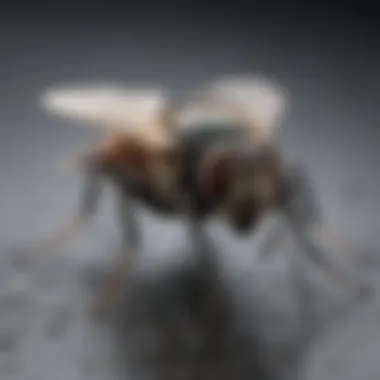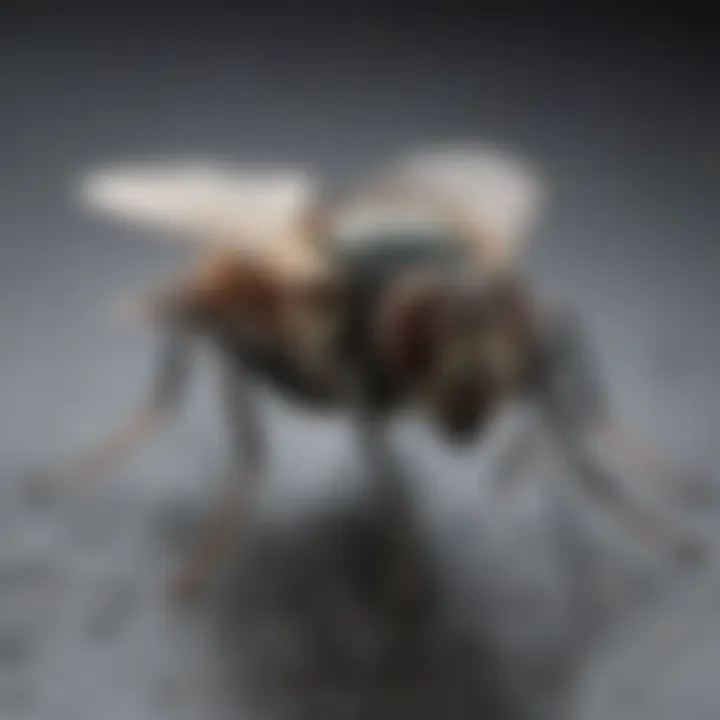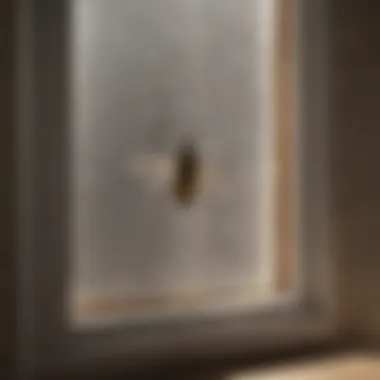Effective Strategies to Keep Flies Out of Your Home


Intro
Dealing with flies in the home is not just an annoyance; it can become a serious hygiene issue. Understanding how to keep flies out of your living space is essential for maintaining comfort and health. This segment will delve into the various strategies to prevent these pests from entering your home, benefiting homeowners who wish to create a safer and more pleasant environment.
Understanding the Pest
Flies are not all the same. Knowledge of their biology and behavior is crucial for effective prevention.
Identification
There are several species of flies that commonly invade homes. The house fly, the fruit fly, and the drain fly are among the most prevalent. House flies can often be identified by their grayish-brown color and four dark stripes on their thorax. Fruit flies are smaller, typically tan with reddish eyes, while drain flies have a fuzzy appearance. Knowing which type of fly you're dealing with can inform your control methods.
Life Cycle
Flies reproduce rapidly. A female house fly can lay up to 500 eggs during her lifespan. The larvae emerge within hours, feeding on organic matter. The entire life cycle, from egg to adult, can be completed in as little as seven days in optimal conditions. This fast reproductive rate means that timely prevention is crucial.
Pest Prevention Strategies
Implementing effective pest prevention strategies can mitigate the likelihood of flies entering your home.
Environment Modification
The environment should be kept clean and free of potential breeding sites. Consider these modifications:
- Remove standing water or damp areas.
- Seal food in containers and clean spills immediately.
- Dispose of organic waste in sealed bins.
- Keep outdoor areas tidy.
Physical Barriers
Physical barriers can physically prevent flies from entering your home. Use:
- Screens on windows and doors.
- Seals and weatherstripping around entry points.
- Fly traps or zappers placed strategically around your home.
Control Methods
If prevention fails, control methods must be implemented.
Chemical Control
Chemical solutions can provide immediate relief from fly infestations. Insect sprays like Raid or commercial fly baits may be used. However, it is essential to follow the instructions carefully to avoid health and environmental risks.
Biological Control
Biological control can offer alternatives to chemicals. Introducing natural predators, such as parasitic wasps, can help keep fly populations in check. This eco-friendly method aligns with environmentally-conscious practices, reducing reliance on synthetic chemicals.
Understanding the biology and habits of flies will help homeowners make informed decisions about prevention and control.
End
Keeping flies out of the house is a multi-faceted approach that requires knowledge of the specific pests, proactive environmental modifications, and effective control methods. By implementing these strategies, homeowners can protect their living spaces from these bothersome intruders.
Understanding the Common Housefly
Understanding the common housefly is critical for effective prevention strategies. This species, Musca domestica, is often underestimated. However, knowledge of its biology and behavior patterns lays the groundwork for various control measures. Flies are not just nuisances; they can transmit pathogens, making them a health hazard in residential areas. By grasping their fundamental characteristics, homeowners can better anticipate and combat infestations.
Biology of the Housefly
The housefly possesses several distinctive biological traits. Adults have a characteristic grayish body, measuring about 6 to 7 millimeters in length. Their large, multifaceted eyes contribute to their exceptional ability to detect motion and environmental changes. Notably, houseflies have mouthparts adapted for sponging and sucking, allowing them to feed on semi-liquid substances. This feeding mechanism plays a crucial role in their attraction to food waste and decaying organic matter.
Houseflies reproduce rapidly. A female can lay as many as 1,000 eggs during her lifespan. Conditions such as temperature and available food can influence their reproductive rate. Understanding this biology is essential. It highlights the urgency of immediate action when observing flies, as a small number can quickly escalate into a larger problem.
Life Cycle and Behavior Patterns
The life cycle of the housefly consists of four distinct stages: egg, larva, pupa, and adult. Eggs are typically laid in moist and decaying organic materials. The larvae, or maggots, emerge quickly, feeding on the surrounding matter. This feeding behavior contributes significantly to their population growth in areas with poor sanitary conditions.
As larvae develop, they eventually pupate, transitioning into adult flies. The entire life cycle can occur in as little as seven days under ideal conditions. Understanding these patterns allows homeowners to identify peak invasion times, particularly in warmer months when flies thrive.
Behaviorally, houseflies are persistent. They are drawn to food sources, warmth, and human activity, often found buzzing near garbage or compost bins. This behavior signifies their role as scavengers, although it makes them undesirable inhabitants in homes. By recognizing these behavior patterns, proactive measures can be taken to deter their entry.
Reasons Flies Enter Homes
Understanding why flies enter homes is essential for creating effective preventive measures. Flies are not just common nuisances; they can contaminate food and transmit diseases. Recognizing their motivations assists homeowners in identifying weaknesses in their living environments that invite these pests.
Attraction to Food Sources


Flies are particularly drawn to food sources because they require nutrients for survival. The presence of exposed food items makes homes especially inviting. Common attractions include:
- Trash: Rotten food or open trash cans are a magnet. Regularly disposing of garbage is vital.
- Spills: Food and drink spills on surfaces can easily attract flies. Immediate cleaning is essential to eliminate potential baits.
- Fruit: Overripe or decaying fruits can attract many fly species. Storing fruits in a refrigerator can help keep them at bay.
Flies have highly sensitive olfactory receptors that can detect food from a distance. This keen sense of smell means even minute food particles left on counter surfaces can lead them inside. By managing food waste and being mindful of cleanliness, homeowners can significantly reduce the allure that homes present to flies.
Warmth and Shelter
Flies not only seek food but are also drawn to warmth and shelter, especially during colder months. Houses provide a refuge from adverse weather conditions, making them desirable environments.
- Interior Heat: Flies thrive in warm conditions. They can find their way indoors where the temperature is regulated. Keeping doors and windows closed during peak seasons can prevent access.
- Sheltered Areas: Garages, basements, and attics can offer ideal spots for flies to rest and breed. Sealing up these areas can help deter infestations.
- Entry Points: Cracks and gaps around doors and windows are often overlooked. Sealing these entry points limits access to warm interiors.
Recognizing these reasons is a foundational step in developing a comprehensive strategy against flies. By addressing the factors that attract them, homeowners can implement effective and sustained measures to keep their living spaces free from these pests.
Preventative Measures to Keep Flies Out
Keeping flies out of the home requires proactive methods. A single fly can lead to multiple others entering your space. It is essential to adopt preventative strategies that deter flies before they become a nuisance. Implementing these measures can save homeowners time, money, and health concerns. In this section, we will delve into key preventative strategies that focus on sealing entry points, managing waste, and maintaining a hygienic living environment.
Sealing Entry Points
Inspecting Windows and Doors
Inspecting windows and doors is a crucial part of keeping flies out. These areas are often neglected, yet they serve as primary entry points. Homeowners should check for any gaps, cracks, or damages that might allow access. This inspection helps identify weaknesses that can be reinforced. By consistently securing these entry points, the likelihood of fly intrusion decreases significantly.
A key characteristic of inspecting is its simplicity. It is a straightforward action that requires minimal time and resources. Regular checks can prevent flies from entering during their peak seasons. A unique feature of proper inspections is that they can reveal not just entry points for flies, but also other possible pest issues. Keeping windows and doors secure can thus be a multifaceted preventive measure. However, it may require ongoing effort and vigilance.
Using Screens Effectively
Utilizing screens effectively is another important strategy. Screens can block flies while allowing fresh air to circulate inside the home. When installed correctly, they serve as a barrier to prevent these pests from entering. Homeowners should ensure that screens are properly fitted and free of holes.
The appeal of using screens lies in their dual function. They enhance ventilation and protect against unwanted insects. A notable feature is that they come in various types, including retractable and magnetic, providing options based on personal preference. While screens are generally effective, maintenance is essential. Torn or poorly fitted screens can reduce their effectiveness, allowing flies access into the home.
Proper Waste Management
Regular Garbage Disposal
Regular garbage disposal plays a significant role in fly prevention. Flies are attracted to decomposing food and waste. By disposing of garbage frequently, homeowners can minimize the temptation for flies to gather. This routine practice reduces the chances of infestations, making it essential in fly management.
The key characteristic of regular disposal is its immediacy. It provides a quick solution to potential fly problems. A unique aspect of this method is that it not only addresses the issue of flies but also promotes general cleanliness in the home. However, it demands consistency. Neglecting garbage removal can easily lead to fly attraction, especially in warm weather.
Utilizing Sealed Containers
Utilizing sealed containers is another effective waste management strategy. Storing food waste and trash in airtight containers limits odors that attract flies. This simple adjustment can drastically impact the presence of these pests around the home.
The primary benefit of sealed containers is their ability to keep smells contained. Flies are less likely to invade areas where no scents entice them. A unique feature of this method is its compatibility with various waste types. Whether it is organic food waste or general trash, sealed containers provide a solution. However, choosing the right container is crucial; poor-quality seals can still allow odors to escape, compromising their effectiveness.
Creating a Clean Environment
Regular Surface Cleaning
Regular surface cleaning is fundamental to keeping flies at bay. Maintaining clean surfaces minimizes food residue that attracts these pests. This practice should include wiping down countertops, dining tables, and other areas where food is prepared or consumed.
The key characteristic is the frequency of cleaning. By integrating daily or weekly cleaning routines, homeowners can significantly reduce food sources that attract flies. A unique advantage of surface cleaning is the psychological benefit it contributes to home satisfaction. However, it can be time-consuming and requires a dedicated effort to maintain consistency.
Managing Drains and Gutters
Managing drains and gutters is often overlooked but is vital for fly prevention. Standing water and organic materials in drains can create breeding grounds for flies. Regular cleaning of these areas can prevent infestations while maintaining home hygiene.
The central benefit of managing these systems is the reduction of stagnant water situations. This can be particularly useful in warm months when fly activity is higher. A unique feature of this approach is its long-term impact; it improves not just fly prevention, but also overall home sanitation. While it requires some effort and routine inspection, the benefits far outweigh the disadvantages, as the intervention can lead to a healthier environment.
Natural and Eco-Friendly Remedies
Natural and eco-friendly remedies are increasingly relevant in pest control discussions, especially regarding flies. Many homeowners prefer these methods due to their safety and environmental impact. The use of essential oils and herbs poses fewer risks to human health and offers a sustainable approach to managing pests.
These remedies can be effective in repelling flies without the harmful effects associated with synthetic pesticides. Moreover, they can enhance the atmosphere of a home, adding pleasant scents while serving a dual purpose in pest prevention. Homeowners must understand the benefits and applications of these solutions for successful implementation.
Essential Oils as Repellents
Essential oils are concentrated plant extracts known for their strong scents. Flies are sensitive to these aromas, which can deter them from entering spaces. Two popular oils, in particular, stand out for their effectiveness in fly repulsion: peppermint oil and lavender oil.
Peppermint Oil
Peppermint oil is widely recognized for its sharp, fresh scent, which is typically unpleasant for flies. This characteristic makes it a beneficial choice for natural fly control. One unique feature of peppermint oil is its versatility. It is often used in various forms, such as sprays or diffusers, allowing homeowners to choose the method that suits them best.
The advantages of peppermint oil include its ability to mask food odors, minimizing attraction for flies. However, some might note its strong scent can be overwhelming in small spaces. Additionally, individuals with sensitivities might experience irritation, so caution is advised when using it.


Lavender Oil
Lavender oil is another effective option known for its calming fragrance. While primarily appreciated for its relaxing properties, it also serves as a natural fly repellent. The floral scent is less pungent than others, which can make it more pleasant to use indoors.
A unique feature of lavender oil is its added benefit of promoting relaxation. This makes it suitable for areas like bedrooms and living spaces. However, compared to more potent oils like peppermint, lavender's effectiveness may be somewhat less pronounced against large infestations. Users should consider combining it with other oils for enhanced results.
Herbal Approaches
In addition to essential oils, certain herbs can also serve as effective fly repellents. The use of plants such as basil and mint has been noted for their insect-repelling properties, making them great additions to gardens or indoor environments.
Basil and Its Usage
Basil is not just a culinary herb; it also offers benefits in keeping flies away. Its strong aroma, similar to that of other essential oils, can deter various insects. Homeowners often keep basil plants in pots near doors and windows to create a natural barrier against flies.
This herb’s popularity stems from its dual utility—it can be harvested for cooking while providing pest control at the same time. However, basil needs sunlight and care to thrive, which may pose a challenge for some gardeners.
Mint Plants Around the House
Mint plants are another effective strategy. Their distinctive scent can repel flies and other pests. Additionally, mint is known for its growth ease and resilience, making it a practical choice for any garden or patio. Planting mint in various areas can naturally deter flies from entering living spaces.
One unique aspect of mint is its tendency to spread quickly. Homeowners should manage its growth to avoid it overtaking other plants. While it offers many benefits, care must be taken to cultivate mint properly to ensure it does not dominate the garden space.
"Utilizing natural remedies offers a sustainable way to keep flies at bay, enhancing both health and comfort in the home."
Chemical Control Options
Chemical control options are an important aspect of managing fly populations effectively. In instances where prevention methods do not suffice, or an infestation occurs, specific chemical treatments can provide quick resolutions. Additionally, chemical solutions are often necessary when dealing with aggressive breeding cycles that can develop in favorable environmental conditions. Thanks to innovation in the pest control industry, there are various insecticides available that can be utilized to target specifically houseflies with minimal impact on the environment.
Choosing Appropriate Insecticides
It is crucial to select insecticides that are formulated to be effective against houseflies while considering safety for humans and pets. Here are several points to bear in mind when choosing the right product:
- Active Ingredients: Look for products containing active ingredients like pyrethrins or permethrin. These ingredients are known for their efficacy against fly species.
- Formulation Type: Insecticides come in various forms, such as sprays, foggers, and bait stations. Each type has its own advantages; sprays allow for targeted application, while foggers cover large areas.
- Usage Instructions: Follow the manufacturer's guidelines for proper use. Different products may have distinct methods of application, and adherence to these instructions ensures maximum effectiveness.
- Environmental Impact: Select products that are classified as low-impact where possible. Some options utilize naturally derived ingredients to reduce harm to ecosystems.
Safe Application Techniques
The application of chemical solutions requires careful attention to ensure both effectiveness and safety. Adhere to these fundamental techniques when using insecticides in your home:
- Personal Protective Equipment (PPE): Always wear appropriate protective gear, including gloves and masks, to prevent exposure to chemicals.
- Ventilation: Ensure the area is well-ventilated during application to reduce inhalation of fumes. Open windows and doors can help.
- Targeted Application: Focus on areas where flies tend to gather, such as near garbage cans, compost piles, or unsealed doors and windows. Avoid broad outdoor applications to protect beneficial insects.
- Follow-Up Procedures: After application, observe the treated areas for effectiveness. Reapply as necessary, ideally following up with preventive measures to discourage future fly activity.
Effective pest management goes beyond immediate solutions; a comprehensive approach incorporating both chemical and non-chemical strategies creates more sustainable results.
Utilizing chemical control options should complement broader preventive measures outlined earlier in the article. By understanding how to choose appropriate insecticides and applying them safely, homeowners can manage fly populations more effectively.
Using Traps Effectively
Traps are one of the critical strategies homeowners can employ to manage fly populations effectively. Utilizing traps not only helps decrease the adult fly count in the home but also serves as a monitoring tool for the level of infestation. The strategic placement of traps can yield immediate results while complementing other exclusion and sanitation efforts.
When implemented correctly, traps can be significant for various reasons. They provide a non-chemical method of control, which is particularly appealing to those with concerns about the use of pesticides around children and pets. Additionally, traps can target specific fly species, reducing the likelihood of unintentionally impacting beneficial insects. Understanding the type of trap used and where to place it is essential for maximizing its efficacy.
Commercial Trap Solutions
Commercial traps for flies come in various forms, each designed to attract and capture flies based on their behavior. One popular option is the sticky fly trap, which employs an adhesive surface to catch flies that land on it. These traps can be hung around entry points such as doors and windows or placed near food sources where flies are commonly seen. The visibility of these traps can also discourage other flies from entering the area.
Another effective commercial solution is the electric fly zapper. These devices use ultraviolet light to attract flies and then eliminate them upon contact with an electrified grid. While effective, placement is crucial to prevent attracting flies to specific areas of the house. Given their method of operation, they are best suited for outdoor areas or garages.
It is also beneficial to look for pheromone traps designed specifically to target houseflies. These traps release compounds that mimic the natural scents that attract flies. This targeted approach can significantly impact pest control around your home without the use of harsh chemicals. When choosing a commercial product, ensure that it is appropriate for your specific fly problem and is safe for your living environment.
DIY Fly Traps
For those who prefer a more hands-on approach, creating DIY fly traps can be an economical and effective solution. One simple method involves using a plastic bottle. Cut the bottle in half and invert the top half into the bottom half. Pour a mixture of sugar water and vinegar into the bottom. The flies are attracted to the sweet scent but cannot find their way out once they enter.
Another effective DIY tactic involves using a jar and a piece of plastic wrap. Fill the jar with bait, such as fruit or apple cider vinegar. Cover the top tightly with plastic wrap and poke small holes in it. Flies will be drawn to the odor, enter through the holes, and be trapped inside.
These DIY traps are not only cost-effective but also allow for customization based on available materials. It is essential to place these traps in areas prone to fly activity but be cautious about their location to avoid attracting more flies into living spaces.
Utilizing traps, both commercially available and homemade, can greatly reduce fly populations in and around your home. With the right traps and placement, it is possible to keep your living space more comfortable and free from unwanted pests.
Understanding Seasonal Fly Activity
Understanding the patterns of fly activity throughout the year is essential for effective prevention strategies. Seasonal variations can greatly impact the presence and behavior of flies in and around homes. By knowing when these pests are most active, homeowners can develop proactive measures to keep them at bay.
Flies are not active year-round. Their activity levels fluctuate based on temperature, humidity, and the availability of food sources. These factors influence their life cycles, reproduction rates, and their propensity to invade residential spaces. Recognizing these patterns allows homeowners to anticipate periods of increased fly activity and adapt their strategies accordingly.
Flies in Warm Weather


As the temperature rises, flies tend to become more abundant. Houseflies, fruit flies, and other species thrive in warm conditions, making summer months a critical time for homeowners to be vigilant. The heat facilitates faster reproduction, which leads to larger populations in a short period.
When the temperature exceeds 70 degrees Fahrenheit, flies can reproduce rapidly. A single female housefly can lay up to 500 eggs in her lifetime, usually in small batches. These eggs hatch into larvae within a day under optimal conditions. Without proper management during warmer months, homes can quickly become infested.
Key Strategies for Managing Flies in Warm Weather:
- Ensure windows and doors are properly sealed.
- Utilize effective window screens to prevent entry.
- Maintain a clean environment, especially around food and garbage.
- Employ natural repellents or traps to reduce fly populations.
Detecting and addressing the presence of flies sooner rather than later becomes imperative as summer progresses.
Overwintering Behaviors
Fly behavior shifts significantly with the onset of colder weather. Many species enter a dormant stage, which allows them to survive through winter. This behavior, called overwintering, is vital for their lifecycle and directly affects their re-emergence in spring.
Flies seek out sheltered areas to overwinter, often finding refuge in basements, attics, and other protected spots within homes. Their presence may initially go unnoticed, but as temperatures rise, they will emerge from these hiding places. Understanding this behavior can help homeowners prepare for a new wave of fly activity.
Practical Tips for Managing Overwintering Flies:
- Seal cracks and gaps in the exterior of the home where flies can enter.
- Reduce clutter around homes, making it less inviting for flies to find shelter.
- Regularly inspect and clean areas where flies may hide, such as behind appliances.
By recognizing changes in seasonal fly activity and implementing preventive measures, homeowners can effectively minimize the risk of infestations throughout the year.
Community Practices for Fly Prevention
Addressing the issue of flies invading homes demands a collective approach. The integration of community practices becomes vital. Community practices unite homeowners toward a common goal, improving local environments and reducing fly populations in and around residential areas. These initiatives not only focus on individual actions but create a synergistic effect, leading to a more significant impact on the overall fly situation.
Engaging in community practices offers numerous benefits. For instance, when neighborhoods band together to maintain sanitation, the cumulative effect creates barriers that discourage flies. Shared knowledge and resources enhance the ability to implement effective preventative measures. Community actions elevate awareness about the implications of neglecting household cleanliness and waste management on fly presence, creating a culture of vigilance.
Moreover, these practices foster relationships among neighbors. They promote an understanding of shared responsibilities and trust, allowing individuals to depend on one another in efforts to maintain their living environments. By uniting, residents can develop a more vigilant approach, ensuring that communal spaces are kept clean and free of potential fly attractants.
Successful community practices involve structured initiatives and active participation from residents. Encouraging everyone to maintain their properties correctly can significantly lessen fly attraction. Regular group clean-up events, shared composting efforts for organic waste, and local policies mandating proper waste disposal can lead to cleaner environments.
"Communities that work together in fly prevention create healthier living environments for everyone."
A collaborative spirit empowers neighborhoods to tackle common threats such as fly infestations effectively. Through sustained community efforts, homeowners can see noticeable reductions in fly numbers, leading to a more comfortable and enjoyable living space.
Neighborhood Initiatives
Neighborhood initiatives represent concrete steps communities can take to prevent fly issues. One of the most effective ways to engage is through developing local clean-up campaigns. These campaigns can include scheduled days when residents come together to clean parks, public spaces, and common areas. Such initiatives not only enhance aesthetics but also remove possible breeding sites for flies.
Another initiative involves creating neighborhood watch programs focused on sanitation. Residents can take turns monitoring waste disposal methods and report violations to local authorities. Educational flyers could also be distributed, emphasizing the importance of proper trash disposal and its influence on fly populations. Additionally, these programs foster accountability among residents as they engage in collective monitoring.
Educational Workshops
Educational workshops play an essential role in community engagement and prevention strategies. They provide platforms for sharing critical information about fly behavior and effective prevention techniques. By organizing workshops, local governments or community centers can invite pest control experts to lead discussions. These experts can offer evidence-based strategies tailored to the community’s specific needs.
Topics could include:
- Best practices for waste management
- Effective sanitation techniques for homes
- Natural repellents to discourage fly attraction
- Understanding fly breeding cycles and management
Workshops also create spaces for residents to voice their concerns and share personal experiences. This information exchange helps develop localized solutions as community members identify specific problem areas and suggest improvements. Furthermore, empowering residents with knowledge inspires them to take responsibility for their spaces while reinforcing communal bonds.
Collectively, community practices for fly prevention can create lasting and substantial impacts. With engagement, initiative, and education, homeowners and neighbors can work toward a common goal of reducing flies and enhancing the quality of life.
Ending
In evaluating strategies for keeping flies out of the home, it is essential to emphasize the significance of a multifaceted approach. The persistence of flies is a common concern for many homeowners, making effective prevention strategies not only practical but also crucial for maintaining a clean and healthy living environment.
Summarizing Effective Strategies
A thorough understanding of the methods available can empower homeowners to make informed decisions. Here are key strategies that have proven effective:
- Sealing Entry Points
- Proper Waste Management
- Creating a Clean Environment
- Natural and Eco-Friendly Remedies
- Chemical Control Options
- Using Traps Effectively
- Understanding Seasonal Fly Activity
- Community Practices for Fly Prevention
- Inspect all potential entryways, including windows and doors.
- Utilize screens that are intact and fitted properly to prevent insects from entering.
- Dispose of garbage regularly and ensure that bins are sealed tightly.
- Use containers that are designed to limit access to pests.
- Regularly clean surfaces and manage food waste to eliminate breeding grounds.
- Pay attention to drains and gutters, keeping them unclogged and clean.
- Essential oils, such as peppermint and lavender, can act as natural repellents against flies.
- Consider planting herbs like basil or mint around the house to deter flies naturally.
- In circumstances when other methods fall short, carefully selecting insecticides is necessary.
- Safe application techniques are vital to protect both family members and pets.
- Explore options such as commercially available traps and try DIY solutions with common household items.
- Awareness of seasonal behaviors can inform preparation measures, particularly in warmer months.
- Engage in local initiatives and attend workshops to stay informed about effective methods and share experiences with neighbors.
The combination of these strategies will provide the best defense against flies, ultimately leading to a more pleasant home atmosphere.







